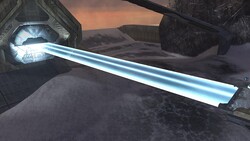Hard light: Difference between revisions
From Halopedia, the Halo wiki
No edit summary |
SPARTAN-347 (talk | contribs) No edit summary |
||
| Line 1: | Line 1: | ||
{{Era|Forerunner|Covenant|Human|UNSC|HCW}} | {{Era|Forerunner|Covenant|Human|UNSC|HCW}} | ||
[[File:Light bridge.jpg|thumb|right|250px|An example of hard light technology on a Forerunner energy bridge on [[Installation 00]].]] | [[File:Light bridge.jpg|thumb|right|250px|An example of hard light technology on a Forerunner energy bridge on [[Installation 00]].]] | ||
'''Hard light''' | '''Hard light''' or '''hard-light''' is a [[Forerunner]] technology that allows light to be transformed into a solid state, capable of bearing weight and performing a variety of tasks. This involves an as-yet unexplained interplay between coherent, high-energy light and gas particles, such as air. | ||
==Background== | ==Background== | ||
Hard light was commonly used in the | Hard light was used extensively by the Forerunners for a variety of purposes. The control panels and interfaces found in many Forerunner installations are composed entirely of hard light, and can react to the touch of a Forerunner or Human despite their utter lack of mechanical components. Hard light was also commonly used in the composition of Forerunner structures and ships, either for aesthetic purposes or as a covering for mechanical and technological mechanisms, such as on the arms of a [[war sphinx]].<ref>'''Halo: Cryptum''', ''pages 93, and 194''</ref> Hard light is also used in the locking mechanisms of Forerunner [[door]]s.<ref>'''Halo: Evolutions - Essential Tales of the Halo Universe''', "Wages of Sin"</ref> [[energy bridge|Bridges]] made of hard light are common throughout Forerunner installations; these bridges are strong enough to bear the load of heavy objects such as a [[Scorpion]] tank, yet can be switched on or off as easily as a normal beam of light. | ||
Forerunner [[design seed]]s also made use of hard light. When activated, the rotating pillars of the machine would emit "scaffolding" of hard light that would fabricate a machine or ship using raw materials obtained on-site. | |||
Hard light was also used in the firing mechanisms of the [[Halo Array|Halo installations]],<ref>'''Halo: Cryptum''', ''pages 307, 310''</ref> and also as a protective structural reinforcement to stabilize and protect the rings against tidal and gravitational forces from other objects.<ref>'''Halo: Cryptum''', ''page 311''</ref> | |||
Many Forerunner ships use hard light technology to form its internal divisions and compartments. This allows a Forerunner ship to easily reconfigure its layout, furnishings or decoration at will.<ref>'''Halo: Cryptum''', ''page 124''</ref> | Many Forerunner ships use hard light technology to form its internal divisions and compartments. This allows a Forerunner ship to easily reconfigure its layout, furnishings or decoration at will.<ref>'''Halo: Cryptum''', ''page 124''</ref> | ||
Most Forerunner structures project a hard light decorative shell over the structural support elements of the building. Almost all Forerunner buildings seen on the Halo installations or the Ark lack this covering; the Forerunners did not install hard-light generators on | Most Forerunner structures project a hard light decorative shell over the structural support elements of the building. Almost all Forerunner buildings seen on the Halo installations or the Ark lack this covering; the Forerunners did not install hard-light generators on the Halos' structures, as they were meant to be purely functional.<ref>'''Halo: Cryptum''', ''page 319''</ref> Additionally, any structures that possessed hard light decor only activated in the presence of Forerunners,<ref>'''Halo: Cryptum''', ''page 242''</ref> although the decoration in the [[Menachite Forerunner complex]] activated when a group of [[human|reclaimer]]s entered.<ref>'''Halo: First Strike''', ''page 143''</ref> | ||
==List of appearances== | ==List of appearances== | ||
Revision as of 22:24, June 3, 2011

Hard light or hard-light is a Forerunner technology that allows light to be transformed into a solid state, capable of bearing weight and performing a variety of tasks. This involves an as-yet unexplained interplay between coherent, high-energy light and gas particles, such as air.
Background
Hard light was used extensively by the Forerunners for a variety of purposes. The control panels and interfaces found in many Forerunner installations are composed entirely of hard light, and can react to the touch of a Forerunner or Human despite their utter lack of mechanical components. Hard light was also commonly used in the composition of Forerunner structures and ships, either for aesthetic purposes or as a covering for mechanical and technological mechanisms, such as on the arms of a war sphinx.[1] Hard light is also used in the locking mechanisms of Forerunner doors.[2] Bridges made of hard light are common throughout Forerunner installations; these bridges are strong enough to bear the load of heavy objects such as a Scorpion tank, yet can be switched on or off as easily as a normal beam of light.
Forerunner design seeds also made use of hard light. When activated, the rotating pillars of the machine would emit "scaffolding" of hard light that would fabricate a machine or ship using raw materials obtained on-site.
Hard light was also used in the firing mechanisms of the Halo installations,[3] and also as a protective structural reinforcement to stabilize and protect the rings against tidal and gravitational forces from other objects.[4]
Many Forerunner ships use hard light technology to form its internal divisions and compartments. This allows a Forerunner ship to easily reconfigure its layout, furnishings or decoration at will.[5]
Most Forerunner structures project a hard light decorative shell over the structural support elements of the building. Almost all Forerunner buildings seen on the Halo installations or the Ark lack this covering; the Forerunners did not install hard-light generators on the Halos' structures, as they were meant to be purely functional.[6] Additionally, any structures that possessed hard light decor only activated in the presence of Forerunners,[7] although the decoration in the Menachite Forerunner complex activated when a group of reclaimers entered.[8]
List of appearances
- Halo: Combat Evolved (First appearance)
- Halo 3
- Halo Wars
- Halo: The Flood
- Halo: Evolutions - Essential Tales of the Halo Universe
- Halo: Cryptum
- Halo Graphic Novel
- Halo: Blood Line